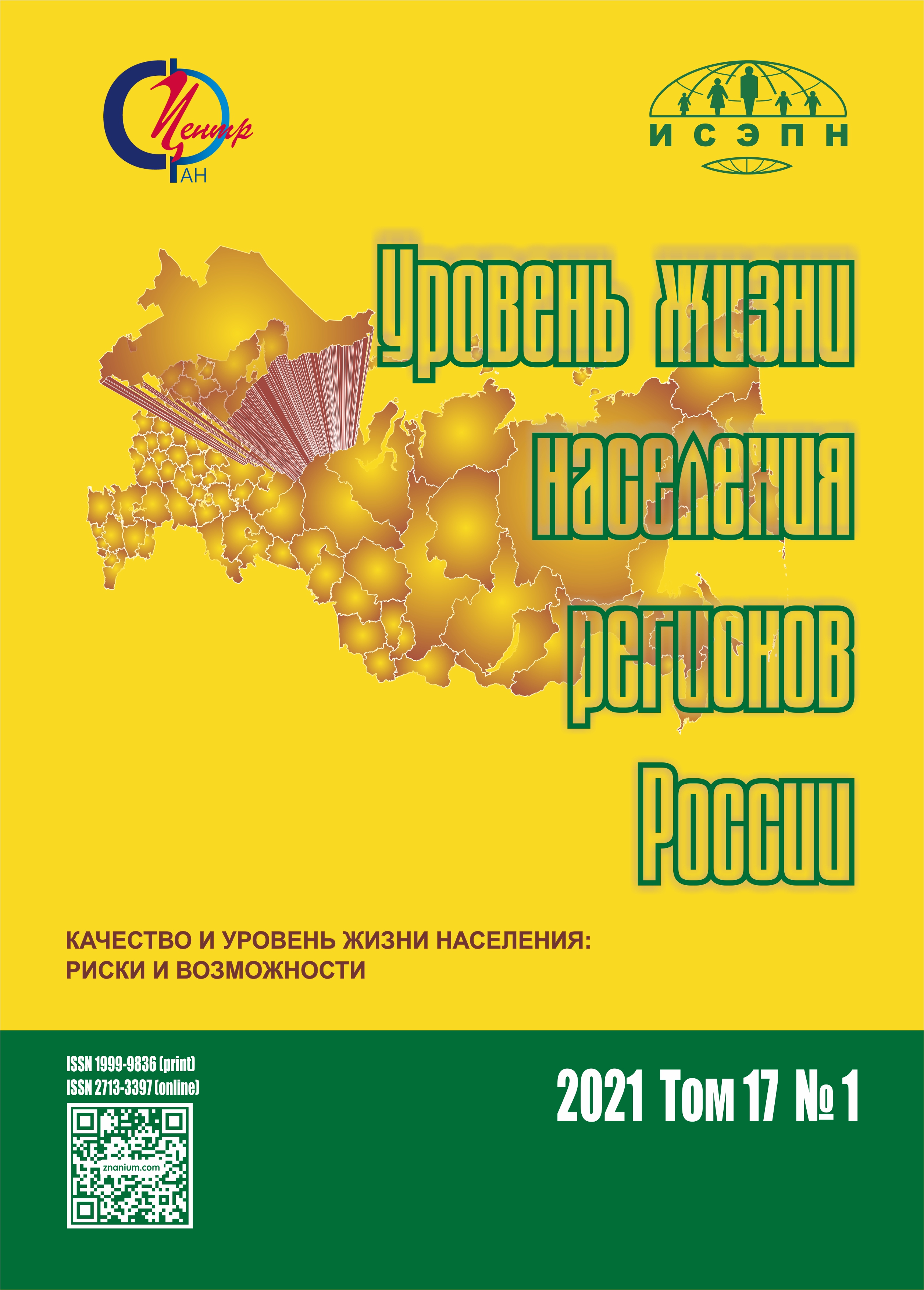Соотношение желаемого и фактического благосостояния семей: по данным социолого-демографического опроса супружеских пар
Научная статья
Для цитирования
Антонов А. И., Карпова В. М., Ляликова С. В. Соотношение желаемого и фактического благосостояния семей: по данным социолого-демографического опроса супружеских пар // Уровень жизни населения регионов России. 2021. Том 17. № 1. С. 121-131. DOI: https://doi.org/10.19181/lsprr.2021.17.1.9
Аннотация
В статье на основе одновременного опроса мужей и женрассматривается соотношение между желаемым и фактическим уровнем душевого дохода семьи (наряду с жилищными условиями) в связи с социально-демографическими характеристиками супругов. Для большинства семей с тремя и более детьми характерны низкие доходы, предполагающие введение материальной компенсации в рамках социальной политики. С другой стороны, задача семейно-демографической политики состоит в повышении нынешней потребности семьи в двух детях, для чего экономического стимулирования недостаточно. В связи с этим требуются внеэкономические меры воздействия, отсюда в центре внимания анализ ценностно-мотивационных аспектов поведения, т.е. супружеских самооценок желаемого и фактического благополучия. Повышение степени разрыва между ними сначала повышает репродуктивные ориентации и реальную детность, а затем понижает их. Социально значимым является критическое значение разрыва – превышение желаемого дохода над фактическим до трёх раз, определяющее семейную направленность поведения. Учёт этого эмпирического обоснованного соотношения важен с практической точки зрения.
Ключевые слова:
разрыв между фактическим и желаемым уровнем дохода, желаемое число детей, жилищные условия, социальное неравенство, расходы на питание, репродуктивные ориентации, семейно-демографическая политика
Литература
Антонов А.И. Семейный образ жизни в сельской России. М.: Изд. дом Ключ-С, 2007. 234 с.
Архангельский В.Н. Факторы рождаемости. М.: ТЕИС, 2006. 399 с.
Гусева М.А., Антонов А.И. Диспозиционная регуляция репродуктивного и самосохранительного поведения в нетипичных семьях с больным ребенком // Социальные аспекты здоровья населения (электронный журнал), 2019. № 65(1). DOI: 10.21045/2071-5021-2019-65-1-2
Бобков В.Н., Одинцова Е.В., Бобков Н.В. Актуальность разработки национальной Программы повышения доходов, снижения бедности и неравенства // Уровень жизни населения регионов России. 2020. Том. 16. № 2. С. 9–24. DOI: 10.19181/lsprr/2020.16.2.1
Борисов В.А. Демографическая дезорганизация России: 1897–2007. М.: NOTA BENE, 2007. 752 с.
Зубаревич Н.В., Сафронов С.Г. Доля продуктов питания в структуре расходов населения регионов России как индикатор уровня жизни и модернизации потребления // Вестник Московского университета. Серия 5. География. 2019. №2. С. 61–68.
Мониторинг демографической ситуации в Российской Федерации и тенденций ее изменения / науч. ред. А.И. Антонов. М.: КДУ. 2008. 301 с.
Семейно-детный образ жизни: результаты социолого-демографического исследования / под ред. А.И. Антонова. М.: Инфра-М, 2018. 540 с.
Социальное неравенство. Изменения в социальной структуре: европейская перспектива / Под ред. В. Воронкова, М. Соколова; пер.с нем. К. Тимофеевой. СПб.: Алетейя, 2008. 160 с.
Сходство и различие ценностных ориентаций мужей и жён по результатам одновременного опроса супругов / под ред. А.И. Антонова. М.: «Перо», 2021. 240 с.
Тихонова Н.Е. Феномен городской бедности в современной России. М.: Летний сад, 2003. 408 с.
Фамилистические исследования. Том 2. Миллион мнений о семье и о себе / отв. ред. А.И. Антонов. М.: КДУ, 2009. 280 с.
Ценности семейно-детного образа жизни (СеДОЖ–2019): Аналитический отчет по результатам межрегионального социолого-демографического исследования; Москва, МГУ имени М.В. Ломоносова / под ред. А.И. Антонова. М.: МАКС Пресс, 2020. 486 с.
Carletto C., Zezza A., Banerjee R. Towards better measurement of household food security: Harmonizing indicators and the role of household surveys // Global Food Security. 2013. Vol. 2. Issue 1. P. 30-40 DOI: 10.1016/j.gfs.2012.11.006
Rangarajan C., Mahendra Dev. S. Counting the Poor: Measurement and Other Issues. Economic and Political Weekly 50, no. 2, 2015. PP. 70-74. DOI: 10.2307/24481307
Sheskin D.J. Handbook of Parametric and Nonparametric Statistical Procedures: Third Edition (3rd ed.). Chapman and Hall/CRC, 2003. DOI: 10.1201/9781420036268
Архангельский В.Н. Факторы рождаемости. М.: ТЕИС, 2006. 399 с.
Гусева М.А., Антонов А.И. Диспозиционная регуляция репродуктивного и самосохранительного поведения в нетипичных семьях с больным ребенком // Социальные аспекты здоровья населения (электронный журнал), 2019. № 65(1). DOI: 10.21045/2071-5021-2019-65-1-2
Бобков В.Н., Одинцова Е.В., Бобков Н.В. Актуальность разработки национальной Программы повышения доходов, снижения бедности и неравенства // Уровень жизни населения регионов России. 2020. Том. 16. № 2. С. 9–24. DOI: 10.19181/lsprr/2020.16.2.1
Борисов В.А. Демографическая дезорганизация России: 1897–2007. М.: NOTA BENE, 2007. 752 с.
Зубаревич Н.В., Сафронов С.Г. Доля продуктов питания в структуре расходов населения регионов России как индикатор уровня жизни и модернизации потребления // Вестник Московского университета. Серия 5. География. 2019. №2. С. 61–68.
Мониторинг демографической ситуации в Российской Федерации и тенденций ее изменения / науч. ред. А.И. Антонов. М.: КДУ. 2008. 301 с.
Семейно-детный образ жизни: результаты социолого-демографического исследования / под ред. А.И. Антонова. М.: Инфра-М, 2018. 540 с.
Социальное неравенство. Изменения в социальной структуре: европейская перспектива / Под ред. В. Воронкова, М. Соколова; пер.с нем. К. Тимофеевой. СПб.: Алетейя, 2008. 160 с.
Сходство и различие ценностных ориентаций мужей и жён по результатам одновременного опроса супругов / под ред. А.И. Антонова. М.: «Перо», 2021. 240 с.
Тихонова Н.Е. Феномен городской бедности в современной России. М.: Летний сад, 2003. 408 с.
Фамилистические исследования. Том 2. Миллион мнений о семье и о себе / отв. ред. А.И. Антонов. М.: КДУ, 2009. 280 с.
Ценности семейно-детного образа жизни (СеДОЖ–2019): Аналитический отчет по результатам межрегионального социолого-демографического исследования; Москва, МГУ имени М.В. Ломоносова / под ред. А.И. Антонова. М.: МАКС Пресс, 2020. 486 с.
Carletto C., Zezza A., Banerjee R. Towards better measurement of household food security: Harmonizing indicators and the role of household surveys // Global Food Security. 2013. Vol. 2. Issue 1. P. 30-40 DOI: 10.1016/j.gfs.2012.11.006
Rangarajan C., Mahendra Dev. S. Counting the Poor: Measurement and Other Issues. Economic and Political Weekly 50, no. 2, 2015. PP. 70-74. DOI: 10.2307/24481307
Sheskin D.J. Handbook of Parametric and Nonparametric Statistical Procedures: Third Edition (3rd ed.). Chapman and Hall/CRC, 2003. DOI: 10.1201/9781420036268
Статья
Поступила: 20.01.2021
Опубликована: 19.03.2021
Форматы цитирования
Другие форматы цитирования:
APA
Антонов, А. И., Карпова, В. М., & Ляликова, С. В. (2021). Соотношение желаемого и фактического благосостояния семей: по данным социолого-демографического опроса супружеских пар. Уровень жизни населения регионов России, 17(1), 121-131. https://doi.org/10.19181/lsprr.2021.17.1.9
Раздел
СОЦИОЛОГИЧЕСКИЕ ИССЛЕДОВАНИЯ








